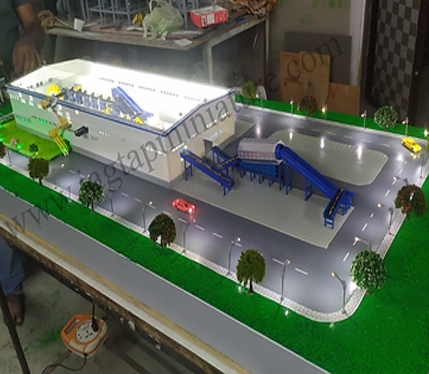Projects

3D Model of Bhandup Residential Architecture Model
-
Scale: 1:100
-
Manufacturing time: 30 Days
-
This a highly detailed 3D architectural scale model of a modern high-rise residential and commercial complex. The model features a multi-store building with numerous balconies, realistic window placements, and interior lighting that simulates occupancy. The podium level includes commercial shops with transparent glass facades, while the base of the model accurately depicts surrounding roads, vehicles, greenery, and street lighting.
-
Such a model is ideal for:
-
• Real estate presentations
-
• Builder-client meetings
-
• Exhibition displays
-
• Marketing and pre-construction visualization
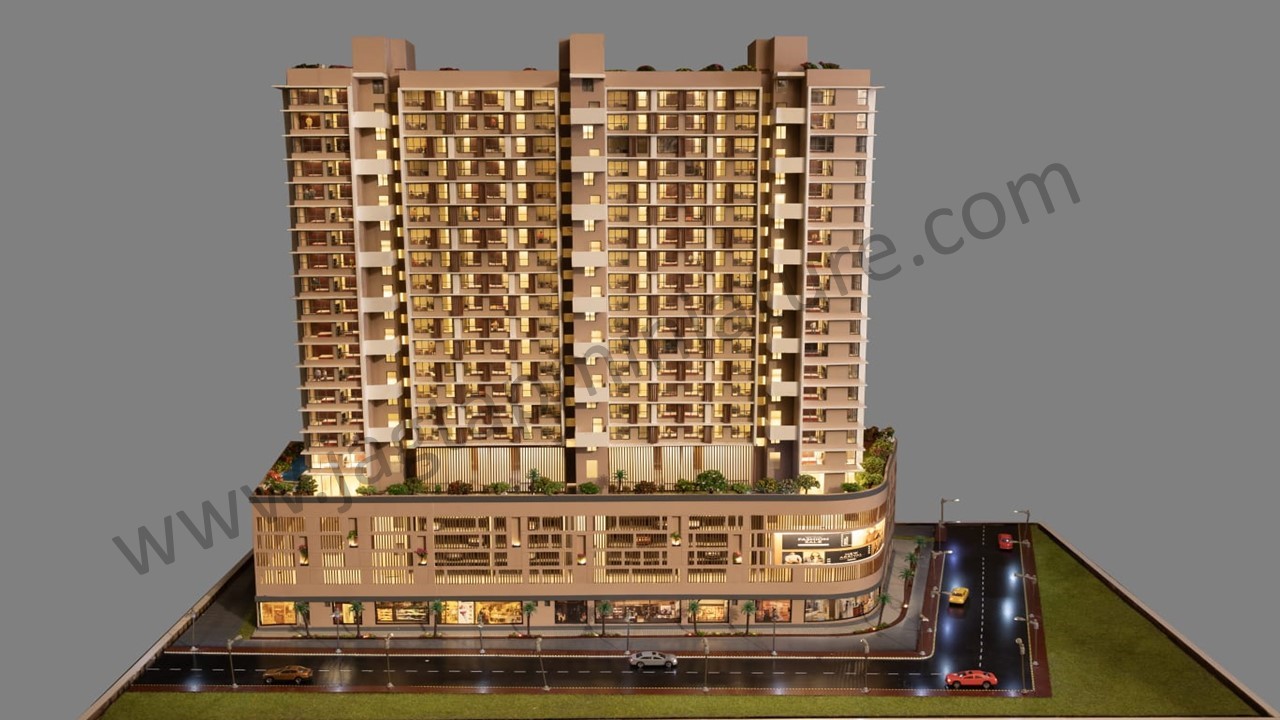

3D Model of Gail (India) Limited Model
-
Scale: 1:700
-
Manufacturing time: 30 Days
-
This highly detailed 3D scale model represents a cutting-edge industrial facility of GAIL (India) Limited, India's leading natural gas processing and distribution company. The model showcases the entire operational infrastructure with precision, including :
-
• Propane Dehydrogenation Unit
-
• Cracker & Reactor Systems
-
• Loading Bays and Transport Trucks
-
• Power & Substation Units
-
• Internal Roads, Entry/Exit Points & Parking Zones
-
• Lush Green Landscaping & Peripheral Vegetation
-
Key highlights include LED lighting for active units, clear labeling of different zones, and miniature vehicles to enhance realism and simulate day-to-day operations. This model is built to scale and serves as an excellent tool for presentation, planning, and educational purposes.
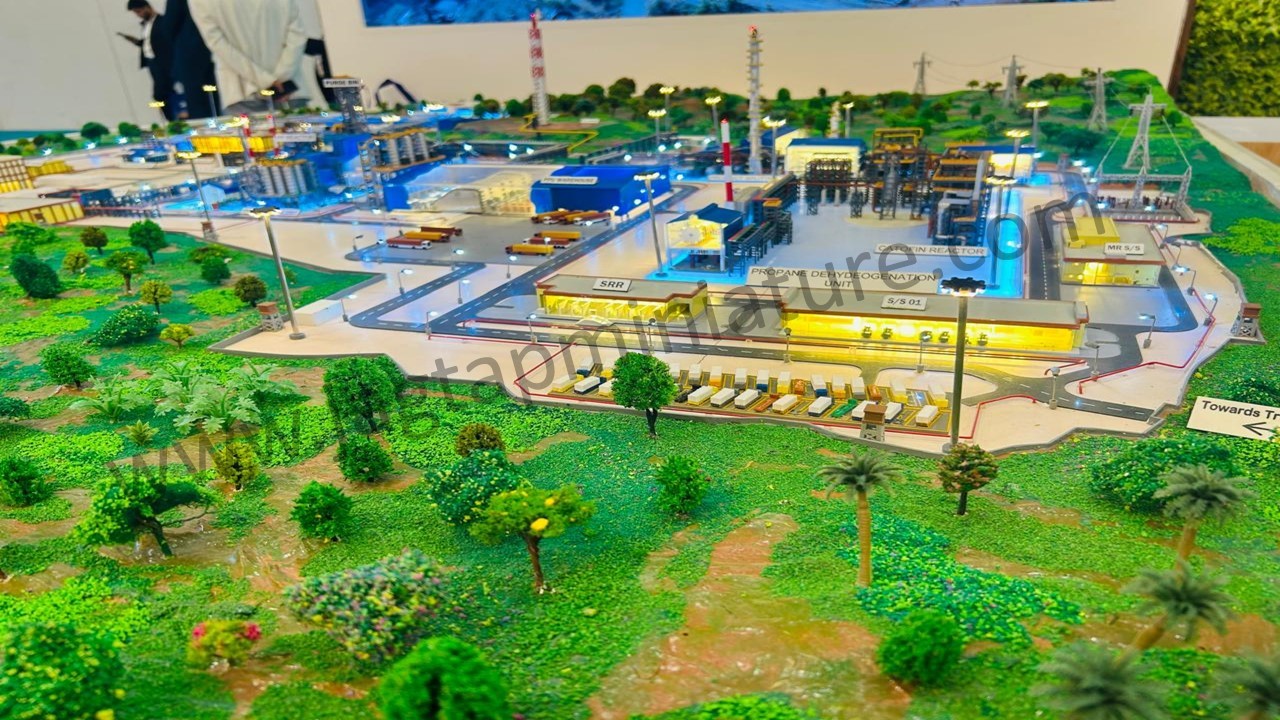

3D Model Of L&T’s Panipath Refinery
-
Scale: 1:350
-
Manufacturing time: 30 Days
-
This meticulously crafted 3D scale model represents the Panipat Refinery Project executed by Larsen & Toubro (L&T), showcasing an advanced industrial setup with structural accuracy and detailed fabrication.
-
Key features include:
-
Complex piping networks, column towers, and process units
-
Detailed steel framework structures for plant operations
-
Refinery control and utility buildings with realistic blue roofing
-
Loading/unloading zones and miniature vehicles for operational realism
-
Integrated lighting system to highlight functional zones and pathways
-
Perimeter roads and boundary demarcations with smooth traffic flow design
-
This model is built with high precision to reflect the real-life scale, structure, and operational flow of the Panipat Refinery. It's designed for project presentations, training, exhibitions, and internal reviews, allowing stakeholders to visualize plant layout and functionality at a glance.
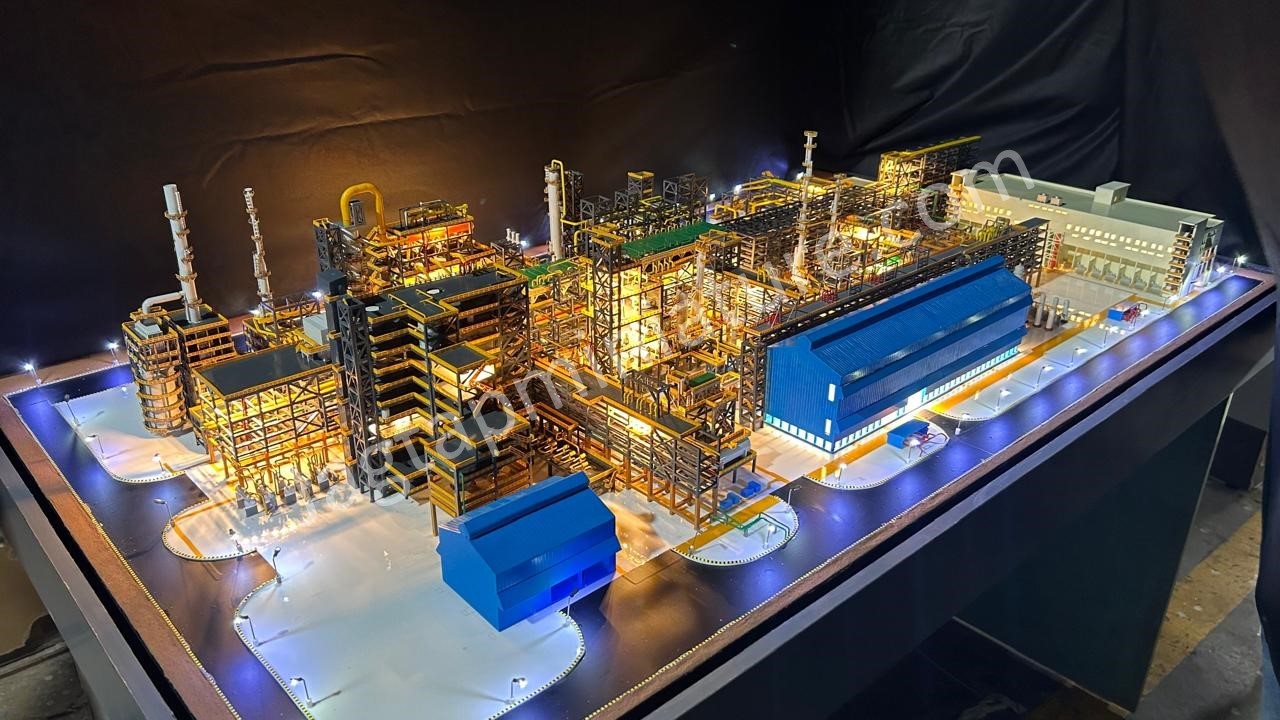

3D Ship Model of LNG
-
Scale: 1:50
-
Manufacturing time: 40 Days
-
This meticulously crafted 3D scale model of a Liquefied Natural Gas (LNG) Carrier, designed and built by Jagtap Miniature Scale Model Making Company. The model showcases the high level of precision and realism, replicating the intricate details of an actual LNG ship — from the deck fittings, pipelines, and lifeboats to the superstructure and bridge.
-
Key Highlights:
-
• Accurate representation of the gas containment and piping system
-
• Realistic color scheme with precise deck layout
-
• High-quality materials and craftsmanship
-
• Mounted on a sturdy display base, ideal for presentations and exhibitions
-
This scale model is perfect for:
-
Corporate gifting
-
Client presentations
-
Trade shows & marine exhibitions
-
Educational and training purposes
-
It offers a visually impressive way to communicate complex engineering and design concepts with clarity.
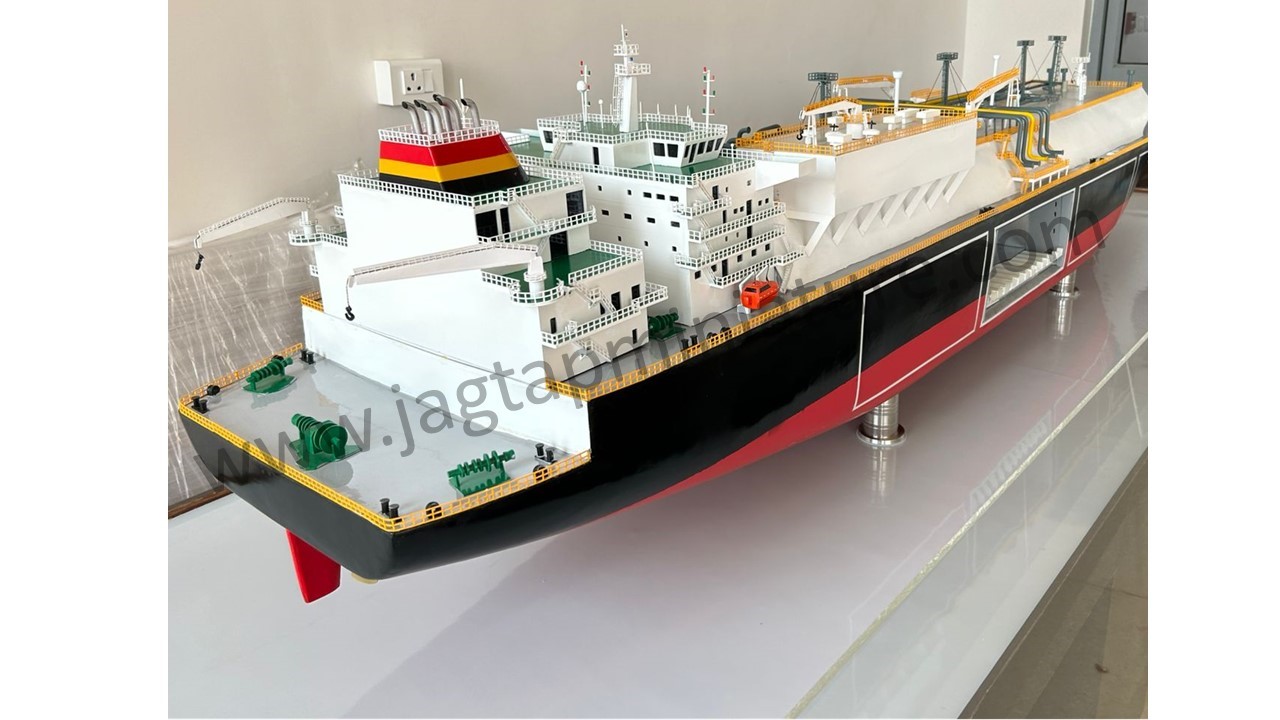

3D MODEL OF "VENTURE" ACCOMODATION AND WORK BARGE
-
Scale: 1:100
-
Size: 970mm X 250mm
-
Manufacturing time: 20 days.
-
A venture accommodation and work barge ship is a type of vessel that is designed to provide temporary living and working accommodations for crews working on offshore projects such as oil and gas exploration or wind farm construction. These vessels are essentially floating hotels and office spaces that can accommodate a large number of crew members for extended periods of time.
-
The venture accommodation and work barge ship typically consists of several levels or decks, with the lower levels dedicated to machinery and storage and the upper levels equipped with living quarters, dining areas, and offices. The vessel is usually equipped with generators, water treatment facilities, and other systems necessary to sustain a large crew for extended periods of time.
-
In addition to providing accommodations, the venture accommodation and work barge ship can also be used to transport personnel and equipment to and from offshore work sites. The vessel is equipped with cranes and other lifting equipment to facilitate the loading and unloading of cargo, and may also have a helipad for helicopter transport.
-
One of the key benefits of using a venture accommodation and work barge ship is that it allows crews to work in remote offshore locations without the need for frequent trips back to shore. This can save time and money, and also increase safety by reducing the need for crew members to travel long distances in smaller vessels.
-
Overall, the venture accommodation and work barge ship is a versatile and essential tool for offshore projects that require a large and sustained presence at sea. These vessels are designed to provide comfortable and functional living and working accommodations for crews, while also serving as a transportation hub and command center for complex offshore operations.


3D MODEL OF KAKINADA GATEWAY PORT
-
Scale: 1:2000
-
Size: 11.25 X 7.25 ft
-
Manufacturing time: 75 days.
-
The Kakinada Gateway Port is a major seaport located in the state of Andhra Pradesh, India. A 3D model of the port can be a useful tool for various purposes, such as planning, analysis, and visualization.
-
To create a 3D model of the Kakinada Gateway Port, several steps need to be followed. First, data about the port's infrastructure, including buildings, docks, cranes, and other facilities, should be collected. This data can be obtained through various sources, such as the project's client, Google references, and ground surveys.
-
Next, the collected data can be processed and converted into a digital format, such as PDF, CDR, and CAD format. The digital data can then be imported into a 3D modeling software, such as SketchUp, 3ds Max, or Blender.
-
In the 3D modeling software, the digital data can be converted into a 3D model by adding textures, materials, and lighting effects. The model can also be scaled and adjusted to accurately represent the real-world dimensions of the port.
-
The final 3D model can then be used for various purposes, such as simulating different scenarios, visualizing the port's layout and facilities, and planning for future development and expansion.
-
Overall, a 3D model of the Kakinada Gateway Port can be a valuable tool for port operators, planners, and stakeholders, providing a detailed and accurate representation of the port's infrastructure and facilities.


3D HEAT EXCHANGER
-
Scale: 1:40
-
Size: 1200mm X 600mm X 900mmht
-
Manufacturing time: 20 days.
-
A 3D heat exchanger model is a computational representation of a physical heat exchanger that is used to simulate the transfer of heat between fluids. Heat exchangers are used in a wide range of industrial applications, including power generation, chemical processing, and HVAC systems.
-
The 3D heat exchanger model typically consists of a set of interconnected tubes or channels through which fluids flow, separated by a solid boundary that conducts heat between the fluids. The model takes into account various physical parameters such as flow rates, temperatures, pressures, and thermal conductivities to simulate the heat transfer process.
-
One of the key advantages of using a 3D heat exchanger model is the ability to accurately predict the performance of the heat exchanger under different operating conditions. This can help engineers optimize the design of the heat exchanger and improve its efficiency.
-
To create a 3D heat exchanger model, engineers typically use specialized software tools that can simulate fluid dynamics and heat transfer. The software allows them to create a virtual model of the heat exchanger and simulate the flow of fluids through it, taking into account various physical parameters such as fluid properties, flow rates, and heat transfer coefficients.
-
Once the model is created, engineers can analyze the results to determine the heat transfer rate, pressure drop, and other parameters that are important for optimizing the performance of the heat exchanger. They can also use the model to test different design configurations and operating conditions to determine the most efficient and cost-effective solution.
-
Overall, a 3D heat exchanger model is a powerful tool for engineers to optimize the design and performance of heat exchangers in a wide range of industrial applications. By accurately simulating the heat transfer process.
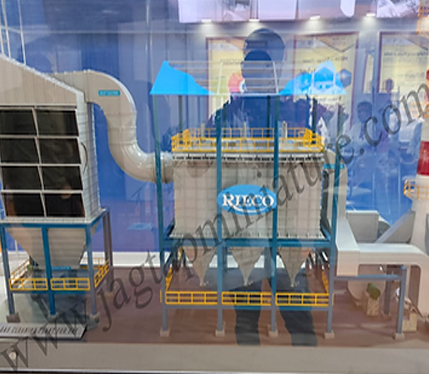

Nibe Defence And Aerospace Limited
-
Scale: 1:200
-
Size: 1100mm X 800mm X 200mm ht max
-
Manufacturing time: 15 days.
-
Creating a 3D model of a defence and aerospace plant can be a complex and challenging task, but it is an essential tool for planning, analysis, and visualization. At our 3D modeling company, we specialize in creating high-quality 3D models of defence and aerospace plants that accurately represent the facility's infrastructure and equipment.
-
To create a 3D model of a defence and aerospace plant, we typically use a combination of techniques, including laser scanning, photogrammetry, and drone mapping. These techniques allow us to collect accurate data on the plant's buildings, machinery, and other infrastructure.
-
Once we have collected the data, we use advanced 3D modeling software to create a detailed and accurate 3D model. Our team of experienced 3D model makers uses the latest software and tools to create realistic textures, materials, and lighting effects that bring the model to life.
-
In addition to creating a 3D model of the plant's infrastructure, we can also simulate different scenarios, such as emergency response, equipment failure, and maintenance procedures. This allows plant operators and personnel to plan and prepare for various situations, improving safety and efficiency.
-
Our 3D models can also be used for training purposes, allowing personnel to familiarize themselves with the plant's layout and equipment before starting work. This can be particularly useful for new employees or for personnel who need to work in different areas of the plant.
-
At our 3D modeling company, we are committed to delivering high-quality work that meets our clients' needs and exceeds their expectations. We pride ourselves on our attention to detail, timely delivery, and exceptional customer service. If you need a 3D model of a defence and aerospace plant, we have the expertise and resources to deliver the results you need.


3D Model Of Divija Old Age Home
-
Scale: 1:200
-
Size: 1000mm X 1000mm X 600mm
-
Manufacturing time: 15 days.
-
This old age home is developed by Swastik foundation in Sindhudurg. Old age home is for the elders whose families have abandoned them.
-
Creating a 3D model of an old age home can be a great way to visualize the layout and design of the building. Here are some steps that a 3D modeler might take to create a 3D model of an old age home:
- Gather information: Start by gathering as much information as possible about the old age home you want to model. This might include floor plans, elevation drawings, photographs, and any other relevant information.
- Choose a software: Select a 3D modeling software that you are comfortable working with. Some popular options include SketchUp, Blender, and AutoCAD.
- Create the base: Begin by creating the base of the building. This can be done by drawing the floor plan in the software or importing it from another source.
- Build the structure: Using the floor plan as a guide, begin building the walls, roof, and other structures of the building. Pay attention to details like the height of the ceilings, the placement of doors and windows, and any unique architectural features.
- Add furniture and fixtures: Once the structure is in place, start adding furniture and fixtures to the model. This might include beds, chairs, tables, and other items that would be found in an old age home.
- Add textures and colors: To make the model more realistic, add textures and colors to the building and furniture. Use reference images to ensure that the colors and textures are accurate.
- Add lighting: Lighting is an important element in any 3D model. Add lights to different parts of the building to create a realistic effect.
- Test the model: Once the model is complete, test it to make sure that everything is working as expected. Make any necessary adjustments to the model.
- Render and present: Finally, render the model to create a high-quality image or animation. This can be used to present the model to others and to promote the old age home.

Remember, creating a 3D model of an old age home requires attention to detail and accuracy. By following these steps and using reference materials, you can create a realistic and informative model that showcases the design and layout of the building.

Waste Management - Recycle system.
-
Scale: 1:40
-
Size: 1900mm X 900mm X 350mm
-
Manufacturing time: 45 days.
- Collection: The miniature depicts the initial step of waste collection, showcasing various bins or containers designated for different types of recyclable materials such as plastics, paper, glass, and metals.
- Sorting: Within the miniature, there are depictions of sorting facilities where collected waste undergoes segregation based on material type. This process ensures that materials are properly sorted for efficient recycling.
- Processing: Next, the miniature illustrates the processing phase where sorted materials are transformed into raw materials suitable for manufacturing. This may involve shredding, melting, or other methods depending on the material type.
- Manufacturing: The miniature may include representations of manufacturing plants where recycled materials are used to produce new products. This showcases the closed-loop nature of recycling, where waste is converted into valuable resources.
- Distribution: Additionally, the miniature may feature transportation systems conveying recycled materials to various manufacturing facilities or distribution centers, emphasizing the importance of logistics in the recycling process.
- Reuse: Finally, the miniature highlights the significance of reusing recycled products, completing the cycle of sustainability. This could be represented by depictions of consumers using products made from recycled materials.
